‘I felt like I was going to fall off’: Lorry rides and the push to make it safer for workers
Despite safety concerns, lorries are still being used to transport Singapore’s migrant workers. A few Singaporeans get a taste of the risks, in a Talking Point episode looking at what more can be done to prevent injuries and deaths.
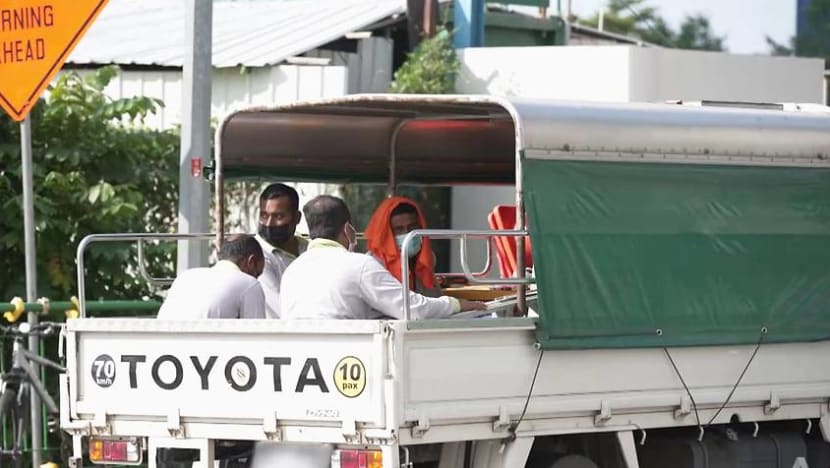
Workers ferried in lorries in Singapore.
SINGAPORE: A few years ago, migrant worker Lee (not his real name) and his colleagues were travelling to work at the back of a lorry that was speeding over humps in a car park.
There were also metal items in the rear deck, and the driver’s carelessness was enough to injure Lee and a colleague.
A scan in hospital showed a muscular tear at Lee’s waist. “It’s been very tough. I can’t bend over and lift things up in one motion,” he said.
Requesting anonymity for fear his work permit would be cancelled because he was speaking up, he added: “Sitting at the back (of a lorry) is quite a dangerous thing to do.”
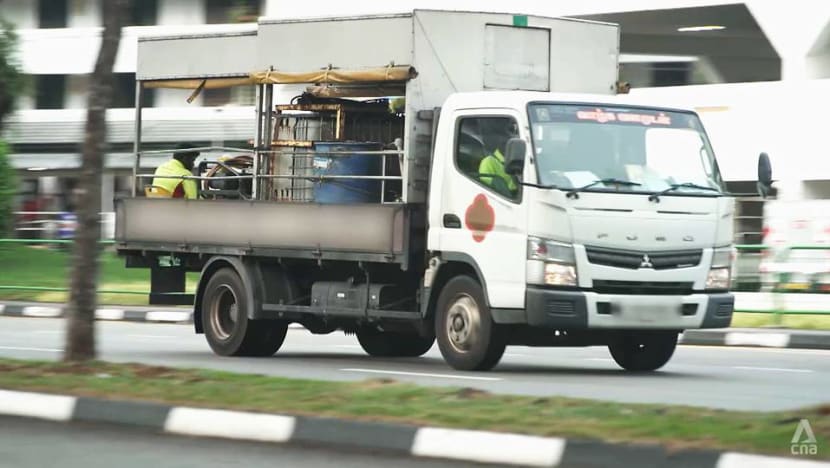
He has worked in Singapore for 14 years, and although he and his co-workers often talk about their mode of transport, he feels it is “pointless” as their boss is already “well aware” of the risks.
“The metal rods aren’t secured; they aren’t fixed to the lorry. They’d fly (in a collision),” Lee said.
The ferrying of workers in lorries has come under the spotlight again after recent mishaps.
There were two reported accidents in April involving lorries transporting workers. In one of the accidents, which occurred on the Pan Island Expressway, two people — Indian worker Sugunan Sudheeshmon and Bangladeshi Toffazal Hossain — died.
READ: Calls to review practice of transporting workers in lorries after 2 accidents
READ: PIE lorry accident: Second worker dies in hospital
In May, there was another accident involving a police van and a lorry ferrying 11 workers.
As at July 19, a Change.org petition for workers to be transported in vans or buses has garnered over 22,000 signatures. So why does the practice persist despite safety concerns? Can injuries and deaths from lorry accidents be prevented?
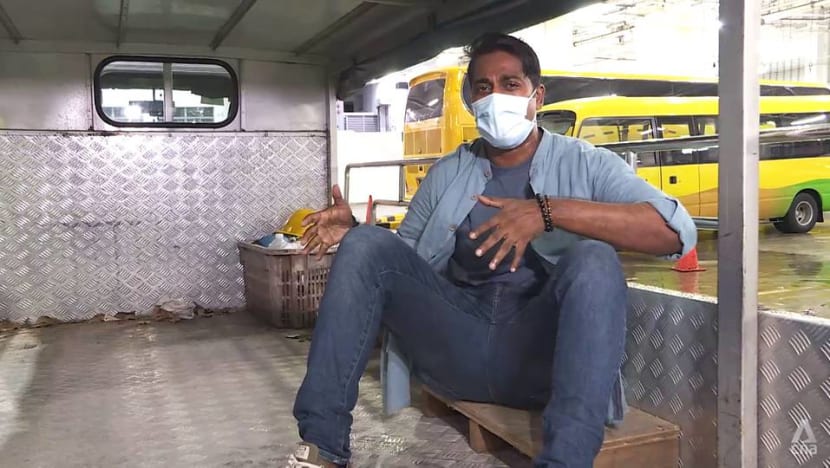
In a Talking Point episode investigating the issue, a few Singaporeans got a taste of riding at the back of a lorry.
They came to the same realisation after finding it difficult to hang on as the lorry made its way around a go-kart circuit at 50 kilometres per hour.
One of them, Dennis Chan, said: “At first, I was like, ‘Oh, this is going to be fun.’ But then in the middle of the circuit, when we were swerving around … I felt like I was going to fall off.”
“I thought it was going to be pretty cool, but after that, I don’t think I’ll do it again,” said Christabelle Sng, another participant.
“There’s nothing really in place, and if there’s a sudden jerk, there’s a real high chance that you’d fly off.”
WATCH: We try riding in the back of a lorry like migrant workers (4:05)
Asked if he would agree to take a lorry to and from work daily, a third participant, Dominic Ng, replied: “No. I have a wife, I have a son; it’s not worth the risk.”
Safety expert Natarajan Krishnamurthy said a lorry is more dangerous than a bus or van because it is structurally “much weaker”. It is also more exposed — lacking restraints, people are thrown around.
Passengers can hold onto a handle under normal traffic conditions, “but if there’s an accident, then the force on the hand would be too much, and the hold would be broken”, he said.
NOT ALLOWED, EXCEPT FOR WORKERS
Yet, ferrying workers in lorries persists because other options are costlier.

Under the Road Traffic Act, goods vehicles are not allowed to be used for passengers, except employees who are carrying out the business of the owner or hirer of the vehicles.
Goods vehicles may also carry sick or injured people in an emergency.
Senior Minister of State (Transport) Amy Khor said in Parliament in May that there are “very significant practical and operational issues — on top of just cost considerations — which is probably why, internationally, it isn’t an uncommon practice”.
READ: Transport Ministry reviewing safety measures for lorries ferrying workers: Amy Khor
With the construction industry “severely” hit by the COVID-19 pandemic, she said further regulations are likely to affect the completion of various building projects and “spell the demise of some companies and the loss of workers’ livelihoods”.

Low-wage migrant workers in sectors like construction form the bulk of lorry passengers in Singapore. And companies buy lorries because they can be deployed in multiple ways, said PQ Builders director Peh Ke Pin.
“If I buy a van, the van would just ferry the workers in the morning and in the night. But (for) the rest of the day, I can’t use it (to transport) materials,” he said.
“But (lorries are) always out transporting materials because we have multiple sites, so the cost per usage is way lower than a van and a bus.”
While the industry may “move towards” ferrying workers in buses and vans in future, he said using lorries “is still the most cost-efficient and practical way” as of now.
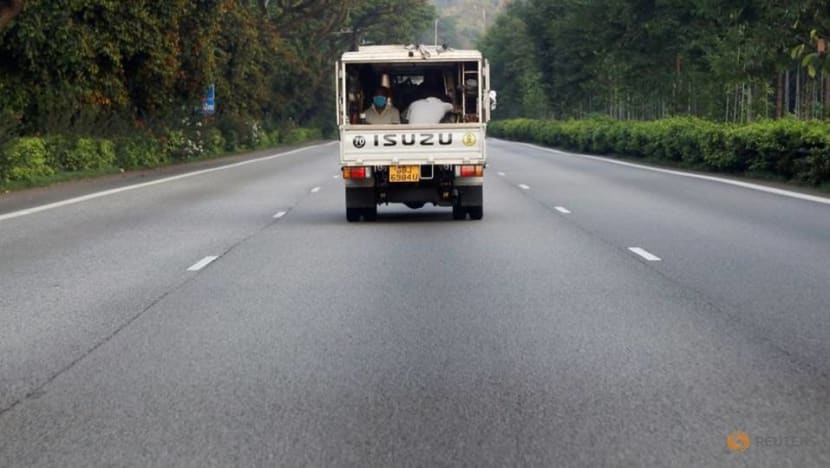
Across countries, practices vary when it comes to ferrying workers. In cities like London and Hong Kong, riding at the back of lorries is prohibited. Bahrain, with a sizeable migrant worker population like Singapore, also banned the practice in 2009.
But countries like Canada, Thailand and the United States allow passengers to be ferried on the rear deck of goods vehicles travelling on roads, albeit with safety precautions and some restrictions, Khor cited in Parliament.
Singapore enhanced some safety rules in 2009 and 2010. For instance, the maximum passenger capacity must be displayed clearly, and front seats must be occupied before people can sit at the back of lorries.
Passengers, when seated, should not be higher than 1.1 metres from the deck of the vehicle. They should have a minimum seating area of four square feet.
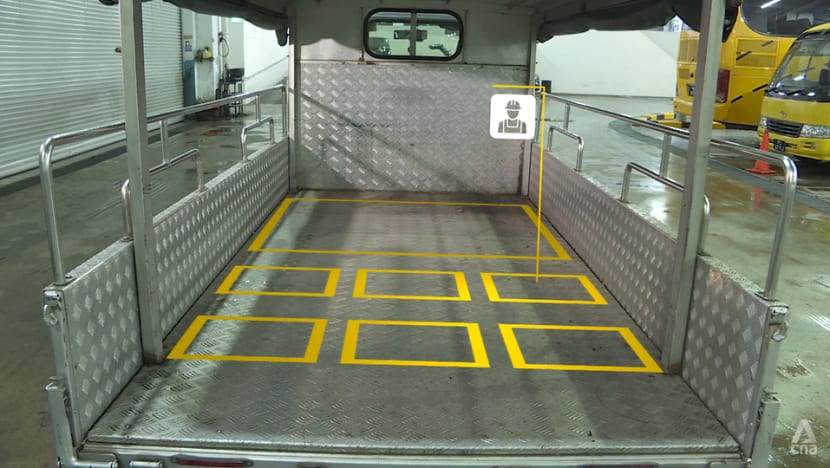
INFLATABLE VESTS AN OPTION?
With help from creative techonologist Akbar Yunus from design-thinking firm Yunora, Talking Point explored some prototypes aimed at making lorries safer for rear passengers.
These ideas were presented to Member of Parliament Alex Yam and Associate Professor Yap Fook Fah, co-director of the Transport Research Centre at the Nanyang Technological University.
The ideas included: Seats with a waist belt; foldable seats with a lap seat belt and a handle; and seats with a three-point seat belt.
Each had its limitations and safety risks. For instance, Yam — who has raised the issue of lorry accidents in Parliament — pointed out that the option with handles meant additional points of impact and potential for injury in a collision.
WATCH: The full episode — Transporting our migrant workers: Can it be safer? (23:19)
And while the three-point seat belt is effective in preventing injuries in cars, this applies only to forward-facing seats, said Yap.
“They’ve not been shown to be effective in side-facing seats in frontal collisions, and there’s potential (for) injury to the neck (due to) sideways motion,” he said.
Seat belts must also be firmly anchored to withstand the force of a collision. “For an average adult involved in a collision (at) 60 km/h, the kind of force (needed) to restrain the passenger is about two tonnes, or 30 Gs,” Yap said.
An option to explore could be safety helmets or even inflatable vests, like what some motorcyclists wear, he suggested.
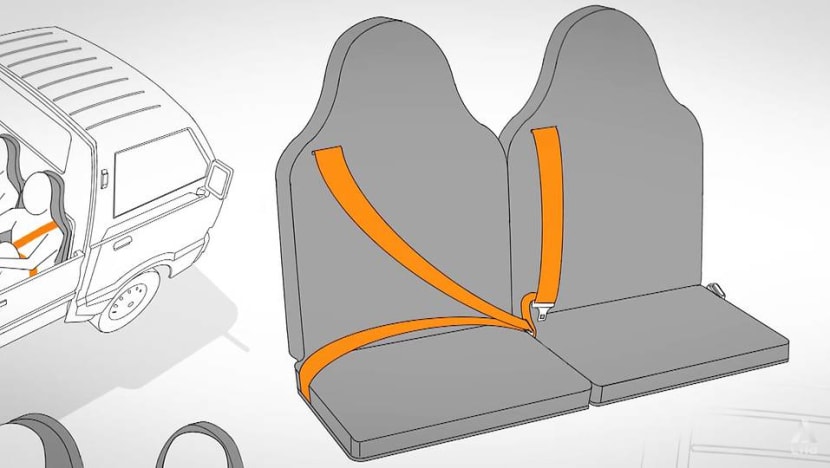
Yam noted that some companies are transporting their workers by bus, and this “hasn’t elevated their cost so much”. This is especially if small companies work together and share resources when transporting workers to the same location or dormitory.
“That’s one direction we can move towards,” he said.
Khor noted in May that the number of persons on board lorries who were injured or killed in road accidents has been on a downward trend over the last decade.
READ: Fewer people killed in lorry accidents since safety measures were introduced in 2009: LTA
In 2019, the injury rate was about 8.1 people per 1,000 lorries, lower than the 8.4 people injured per 1,000 motor vehicles in general.
As for deaths, an average of nine persons on board lorries were killed per year in road accidents from 2011 to 2015. This dropped to 2.6 per year from 2016 to last year.
The Government will “continue to review the safety rules” and engage stakeholders “to see how to enhance these measures”, said Khor.
Watch this episode of Talking Point here. The programme airs on Channel 5 every Thursday at 9.30pm.












